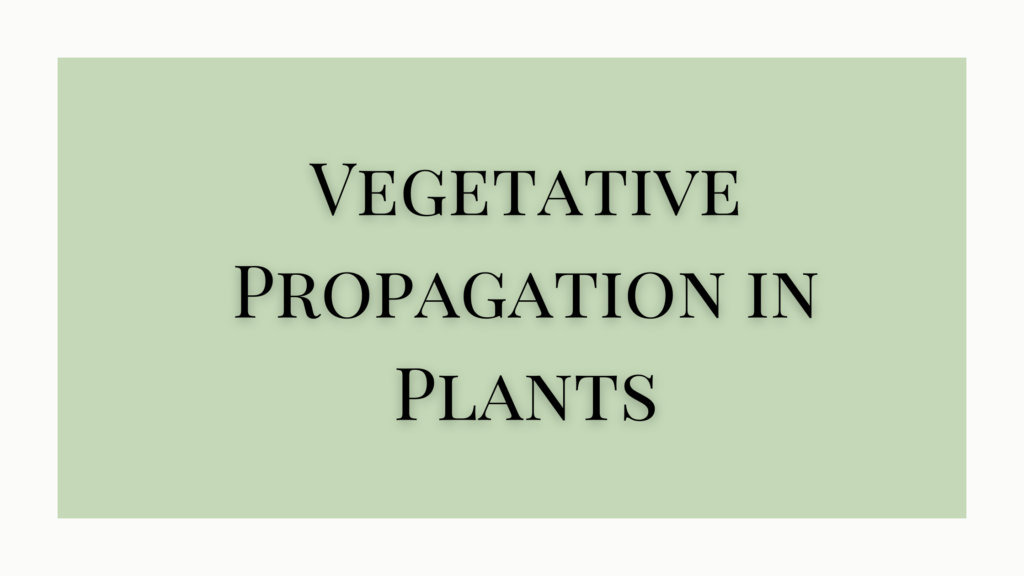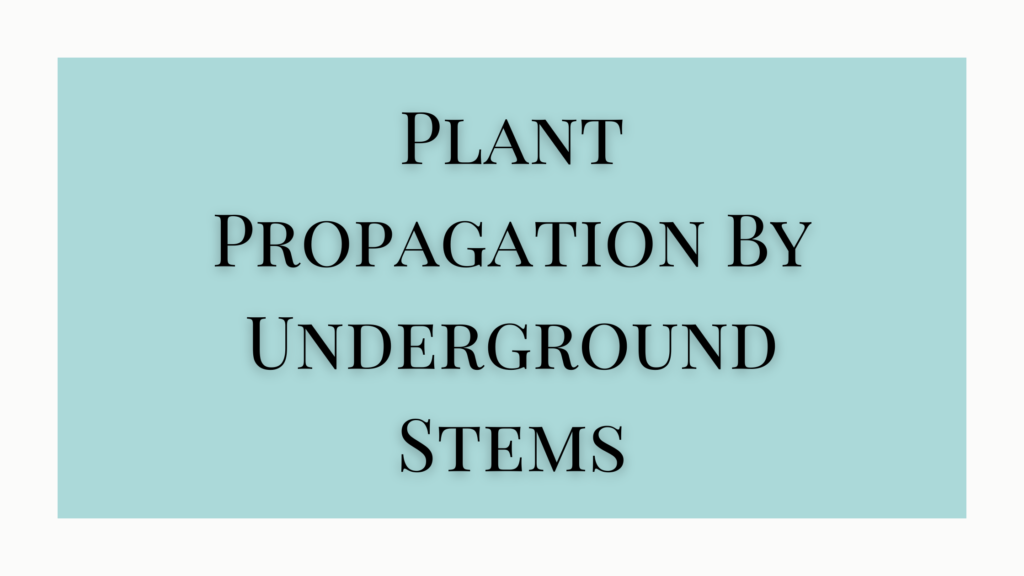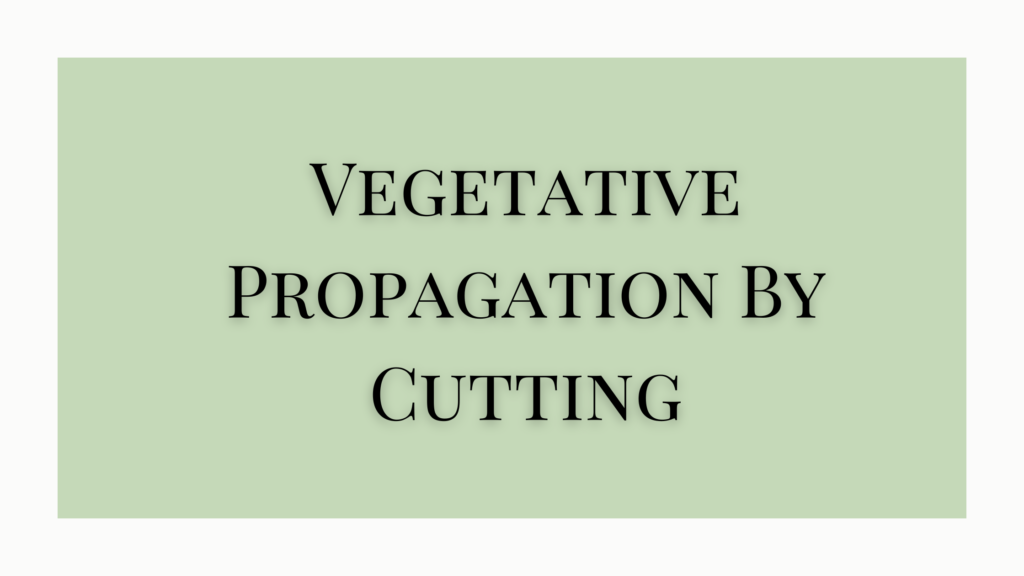Vegetative Propagation in Plants: Advantages & Disadvantages
A wide variety of plants are commercially propagated through asexual or vegetative means. Asexual reproduction involves propagation through vegetative parts of plants so that the new individual is exactly like the mother plant and mostly possesses all the characteristics of the mother plant.
It is well established that all living cells are totipotent. It means that a living cell is the smallest unit of a plant that has all the capabilities necessary for regenerating into a whole plant. When conditions are favorable, a plant can regenerate its missing parts.
Thus a stem cutting forms a root, a root cutting develops a shoot, a leaf cutting develops both root and shoot. Again when grafting is done, vascular connection between the stock and the scion is established, resulting in a new plant with root and shoot systems of different sources. This is another kind of regeneration where the missing links between tissues are established.
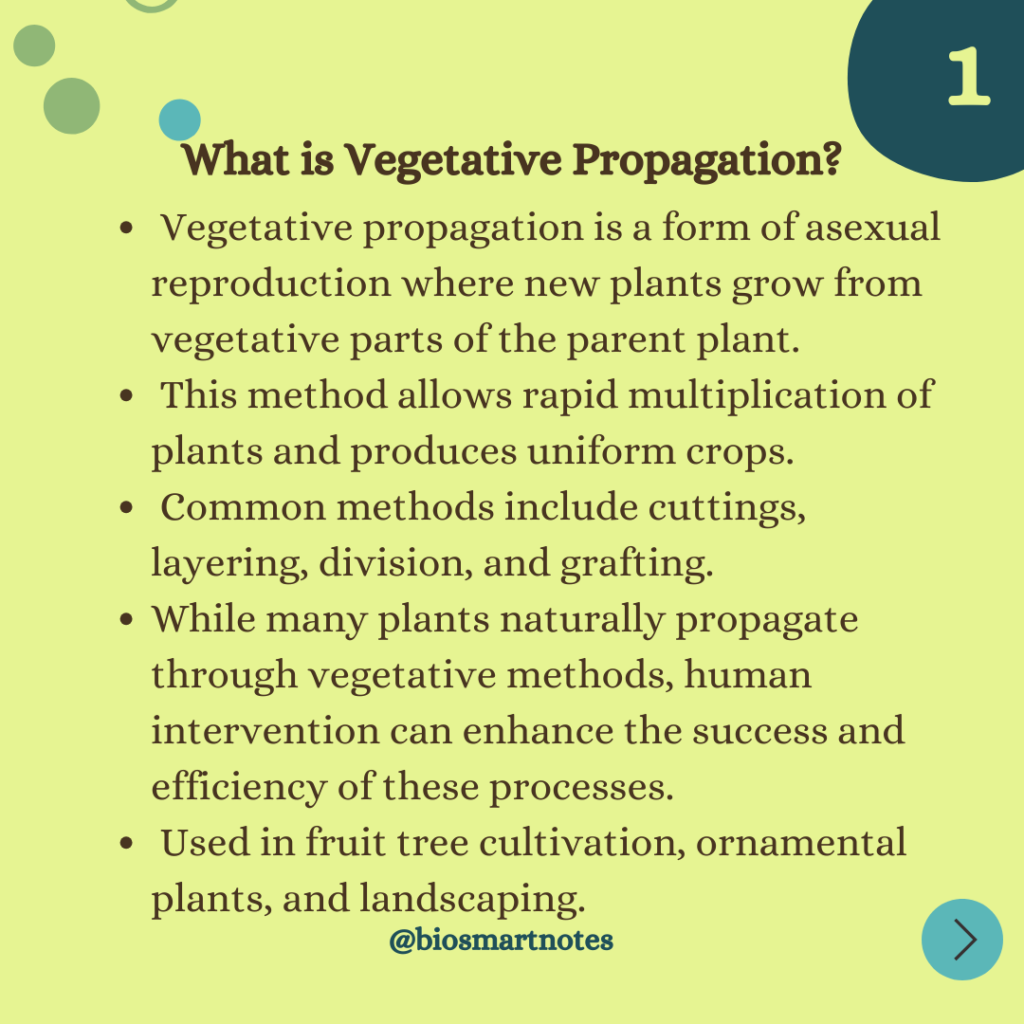
Advantages of Vegetative Propagation in Plants
There are several reasons for using vegetative means as a method of plant propagation. The important reasons are as follows.
- Many horticultural plants normally produce little or no viable seeds. Common examples include varieties of banana, pineapple, orange, rose, grapes, etc. The edible seedless fruits are economically important crops. Unless they can be vegetatively propagated, perpetuation of these plants is not possible and they will be lost in no time.
- Most of our choicest fruits such as mango, citrus, apple, peach, etc, are cross-pollinated plants and are naturally highly heterozygous. Such cross-pollinated plants are not true to type and have lost many of their unique characteristics when raised from seeds. Eg. Seeding mango varieties like Langra and Desheri, bear fruits quite unlike those of parent plants. The fruits vary in their color, size, shape, maturity period, chemical composition, quality, keeping quality, and other characteristics. In contrast, the trees raised by vegetative means such as grafting, bear fruits just like those of the trees from which the scion has been collected. Thus asexual propagation is the ideal method for maintaining the characteristics of each variety or cultivar.
- Propagation by vegetative means is easier, more rapid, and economical than that by seeds. In some cases, germination is very slow, or poor, or there will be dormancy problems, etc. Sometimes, the seeds may lose their viability as in the case of mango, litchi, citrus, etc.
- Certain species or varieties are susceptible to some insects or diseases whereas others may be largely or entirely resistant. Such resistant varieties are mainly propagated through vegetative methods to preserve their desirable characteristics.
- Budding and grafting may be used to make certain fruits adaptable to unfavorable environmental conditions. Certain rootstocks are better adapted to the environment than the roots of the variety desired. For example, trifoliate oranges are much better adapted to severe winter freezing than other stocks. Similarly, rangpur lime is more salt tolerant than other varieties. Of citrus root socks. Here, a scion is taken from the vulnerable variety and grafted with the stock of the tolerant variety to get the desirable results.
- Vegetatively propagated plants are usually less vigorous than seed-propagated plants. By using certain rootstocks, the size of the vigorous plants can be controlled greatly. Making the vigorous plants shorter or smaller makes it easier for orchard operations such as grooming, spraying, harvesting, etc, easier and more convenient.
- Vegetatively propagated plants are precautious in bearing fruits, sometimes, they flower much earlier than seed-propagated plants. Eg, Mango takes at least 8-10 years to flower whereas grafts flower within 3-4 years.
- One of the other benefits of vegetative propagation is in the case of self-incompatible fruit plants. Instead of planting occasional varieties suitable for pollination, a single branch of the pollinizer variety is grafted onto the main variety. An inferior variety can be made into the choicest variety by means of top working when a desired scion is grafted to the existing stock.
- Plants are propagated asexually to perpetuate a particular form of the plant. Eg. Citrus trees are normally thorny, especially in the juvenile stage. But when buds collected from thornless portions of mature plants are used for propagation, the size of thorns is greatly reduced, resulting in budded plants. This method is highly useful for growing ornamental plant varieties.
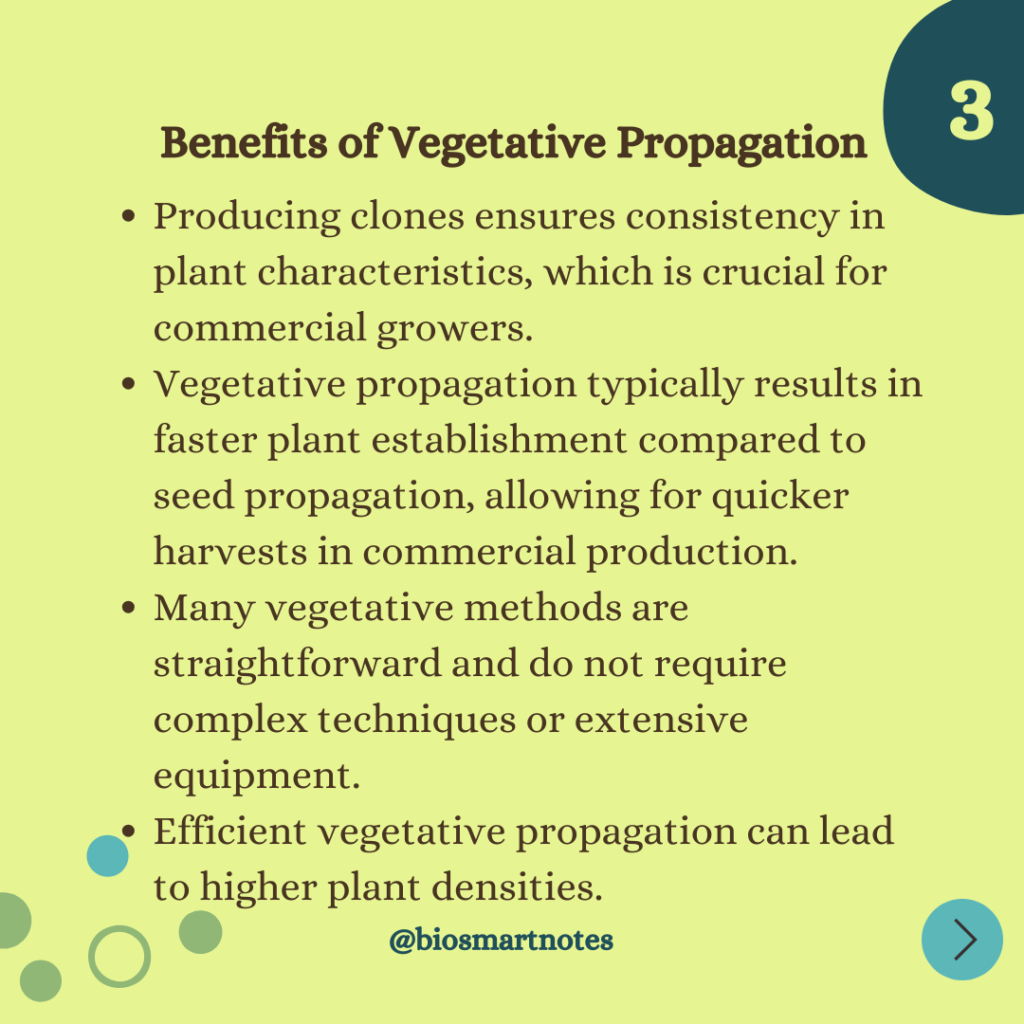
Limitations of Vegetative Propagation in Plants
There are certain limitations to using vegetative propagation methods.
- No new variety can be evolved through vegetative methods of propagation.
- For some varieties, vegetative propagation is more expensive than seed propagation.
- It is a specialist’s job and requires special training and knowledge on the part of plant propagation.
- Vegetatively propagated plants are comparatively short-lived. The lack of a tap root system in these plants results in poor anchorage in the soil. Consequently, such plants are easily uprooted by storms and other such conditions.
Types of vegetative propagation in plants
There are different types of vegetative propagation such as through roots, underground stems, leaves, runners, cuttings, layering, grafting, budding, etc.
Vegetative Propagation By Roots
Some plants are propagated using a section of their root as well. It is not a popular practice and many gardeners are unaware of this method. This is a semi-artificial method of propagation.
Root cuttings are especially taken from woody plants during their dormant season. Such roots are planted in the proper medium and will generate new roots. Later it will form its own shoot and root system to grow into a new plant.
Examples of plants propagated by root cuttings include rose, lilac, fig, raspberry, blackberry, etc. Their roots are usually propagated outside.
Method of Vegetative Propagation by Roots
- The cuttings should be 2-6 inches long for larger plants and trees.
- The cut should be straight near its proximal end.
- Then a lateral cut is made on the dorsal side of each cutting.
- Compile the cuttings together and tie them together in the same direction. It is important to maintain the right orientation of the cuttings to enable proper rooting.
- Store the cuttings for 3 weeks at 40 degrees Fahrenheit in a moist environment.
- After 3 weeks the cuttings are taken out and planted 2-3 inches apart in garden soil. While planting ensure that the proximal ends are 2-3 inches deep in the soil.
For smaller plants, the cuttings are a mere 2-3 inches long and only half an inch into the soil while planting. Either way, the planted cuttings are protected using a plastic bag until their new shoot develops. Root cuttings with a new shoot system are transplanted when they develop 4-6 leaves.
Vegetative Propagation by Modified Roots
Propagation by thickened underground fleshy roots is common in the cases of sweet potato, Dahlia, Canna, etc. They are distinguished by tubers. They lack nodes and internodes but buds are present on their crown or stem end.
Propagation Method
The fleshy roots of sweet potatoes, Dahia, etc produce adventitious roots at the proximal end which tend to restrict the number of sprouts per root. When these roots are treated with 2-3D or ethrel (a plant growth regulator) before planting, an increase in the number of sprouts per root will be visible.
Normally, Dahlia forms a cluster of fleshy roots at the base of the flowering stem. After flowering is over, the root clusters are dragged out and stored in sand, until the next planting. Before planting, the cluster is broken up and care is taken so that each root contains a heel (meeting point of stem and root) of true stem tissue. One to several buds arise from the end of each fleshy root.
Vegetative Propagation By Leaves and Stem
Many plants with thick and fleshy leaves can produce plantlets on their leaves. This is a simple and efficient method of vegetative propagation and can occur naturally and artificially. Naturally, some plants grow a foliar embryo which can grow into a new plant. Platelets on the leaves could also be induced artificially, from leaf cuttings.
Leaf cuttings should be made only from those leaves that have recently expanded. Immature leaves or older leaves should not be used. Sometimes, the leaf cuttings do not produce the same type of plants. For eg, Sansiveria- variegated variety may produce a green variety without variegations.
Leaf Petiole
Leaf petiole cuttings will have a leaf blade and a part of its petiole. When planted in an appropriate medium, they grow new roots from the base of the petiole. As the roots grow enough for transplantation, these cuttings are transplanted into a proper growing medium. Leaf petiole cuttings are used to propagate plants such as African violet and Peperomia.
Leaf Sections
Some plants can be propagated using sections of leaf, which are 5 to 10 cm long. They are cut at an angle to the veins. These cuttings will then be sprayed with fungicides to avoid infections and are planted during favorable conditions, under partial shade. A new plant will develop from the base of these leaf sections.
Runners
A runner is a long, slender stem that grows from the axil of the leaf at the crown of a plant and trails along the ground to form a new plant at one of the nodes. The daughter plant in turn produces leaves and adventitious roots. The detached branch can grow independently as in the case of Strawberry grass, Centella etc.
Offsets
An offset is a short, thickened stem of a rosette-like appearance developing from the base of the main stem. Many plants are propagated by offsets, especially water plants such as Eichoria, Pistia, etc, and date palms.
Offsets are removed from the main stem by a sharp knife. If they have well-developed roots, they can be planted as it is, just like any rooted cutting.
Suckers
A sucker is a short plant-like development arising from the underground parts of the plant. Suckers develop from axillary buds located at the nodes of underground runners. They are dug out and cut from the parent plant. In some cases, a part of the old root may be retained although the new roots arise from the base of the sucker. Eg. Banana, pineapple, Chrysanthemum.
Crown
The term ‘crown’ in horticulture designates the part of a plant at the surface of the ground, from which new shoots are produced. In herbaceous plants (perennials), the crown is the part of the plant from which new shots arise annually.
In certain plants like African violet, the stem is very short from which leaves are produced in a rosette-like arrangement. The entire body of a plant is often referred to as the crown. Lateral roots or offsets are produced from the crown. The division of crowns is an important method of propagation for herbaceous perennial plants.
References
- Plant Propagation by Leaf, Cane, and Root Cuttings | NC State Extension Publications. (n.d.). https://content.ces.ncsu.edu/plant-propagation-by-leaf-cane-and-root-cuttings-instructions-for-the-home-gardener
- Plant Propagation: M. K. Sadhu
